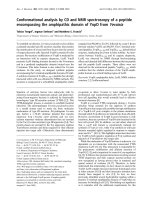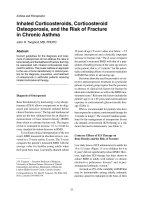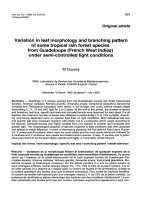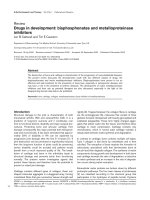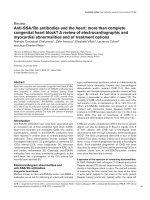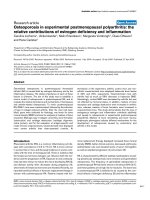Báo cáo y học: "Variations in brachial plexus and the relationship of median nerve with the axillary artery: a case report." pps
Bạn đang xem bản rút gọn của tài liệu. Xem và tải ngay bản đầy đủ của tài liệu tại đây (406.29 KB, 5 trang )
BioMed Central
Page 1 of 5
(page number not for citation purposes)
Journal of Brachial Plexus and
Peripheral Nerve Injury
Open Access
Case report
Variations in brachial plexus and the relationship of median nerve
with the axillary artery: a case report
Suruchi Singhal*, Vani Vijay Rao and Roopa Ravindranath
Address: Department of Anatomy, St John's Medical College, Bangalore – 560034, India
Email: Suruchi Singhal* - ; Vani Vijay Rao - ; Roopa Ravindranath -
* Corresponding author
Abstract
Background: Brachial Plexus innervates the upper limb. As it is the point of formation of many
nerves, variations are common. Knowledge of these is important to anatomists, radiologists,
anesthesiologists and surgeons. The presence of anatomical variations of the peripheral nervous
system is often used to explain unexpected clinical signs and symptoms.
Case Presentation: On routine dissection of an embalmed 57 year old male cadaver, variations
were found in the formation of divisions and cords of the Brachial Plexus of the right side. Some
previously unreported findings observed were; direct branches to the muscles Pectoralis Minor and
Latissimus dorsi from C6, innervation of deltoid by C6 and C7 roots and the origin of lateral
pectoral nerve from the posterior division of upper trunk. The median nerve was present lateral
to axillary artery. The left side brachial plexus was also inspected and found to have normal
anatomy.
Conclusion: The probable cause for such variations and their embryological basis is discussed in
the paper. It is also concluded that although these variations may not have affected the functioning
of upper limb in this individual, knowledge of such variations is essential in evaluation of unexplained
sensory and motor loss after trauma and surgical interventions to the upper limb.
Background
The brachial plexus is usually formed by the fusion of the
anterior primary rami of the C5-8 and the T1 spinal
nerves. It supplies the muscles of the back and the upper
limb. The C5 and C6 fuse to form the upper trunk, the C7
continues as the middle trunk and the C8 and T1 join to
form the lower trunk. Each trunk, soon after its formation,
divides into anterior and posterior divisions. The anterior
divisions of the upper and middle trunks form the lateral
cord, the anterior division of the lower trunk continues as
the medial cord and the posterior divisions of all three
form the posterior cord. The cords then give rise to various
branches that form the peripheral nerves of the upper
limb. The anterior divisions supply the flexor compart-
ments of upper limb and the posterior divisions, the
extensor compartments. Since the brachial plexus is a
complex structure, variations in formation of roots,
trunks, divisions and cords are common. The present
study deals with some of the common variations and
some hitherto unknown variations of the brachial plexus.
Axillary artery passes between the lateral and medial cords
of the plexus. The medial root of median nerve crosses the
axillary artery to unite with the lateral root to form the
Published: 3 October 2007
Journal of Brachial Plexus and Peripheral Nerve Injury 2007, 2:21 doi:10.1186/1749-7221-2-
21
Received: 20 July 2007
Accepted: 3 October 2007
This article is available from: />© 2007 Singhal et al; licensee BioMed Central Ltd.
This is an Open Access article distributed under the terms of the Creative Commons Attribution License ( />),
which permits unrestricted use, distribution, and reproduction in any medium, provided the original work is properly cited.
Journal of Brachial Plexus and Peripheral Nerve Injury 2007, 2:21 />Page 2 of 5
(page number not for citation purposes)
median nerve which is lateral and anterior to the axillary
artery.
Case presentation
The study was done in the Department of Anatomy, St.
John's Medical College, Bangalore. On routine dissection
of an embalmbed 57 year old male cadaver, variations in
the formation of the Brachial plexus of the right side were
found. The clavicle and the scalenus anterior were cut to
expose the roots and trunks of the plexus. The divisions
and their branches were followed to the muscle they sup-
plied for confirmation. The left side brachial plexus was
also inspected and was found to be normal.
The brachial plexus was formed from roots C5, C6, C7, C8
and T1 (Figure 1 and 2). The upper trunk was formed by
the union of C5 and C6. Before joining the C6, the C5
gave a direct branch to the Subclavius Muscle and the Dor-
sal scapular Nerve. Similarily the C6 gave two small direct
branches to Pectoralis Minor and a large branch to the Lat-
issimus Dorsi Muscle (Thoracodorsal Neve).
The upper trunk after its formation gave the Suprascapular
nerve and then divided into an anterior division and a
posterior division. The posterior division gave 2 branches
to the Subscapularis, a branch to Pectoralis major and
then fused with the posterior branches of middle and
lower trunks. This fused portion was the posterior cord
lying posterior to the axillary artery and it gave one branch
to subscapularis and continued as the Axillary nerve. The
anterior division of the upper trunk gave a branch that
joined with the anterior division of the middle trunk to
supply the deltoid muscle. It then joined the anterior divi-
sion of middle trunk completely to form the lateral cord
that lay lateral to the second part of axillary artery. The lat-
eral cord gave rise to a direct branch to the coracobrachia-
lis, the lateral root of the median nerve and thereafter
continued as the musculocutaneous nerve. The musculo-
cutaneous nerve gave two communicating branches to the
median nerve and the lateral root gave a communicating
branch to the first communicating branch of the median
nerve.
The middle trunk gave a thin branch that fused with a
branch of the anterior division of upper trunk to supply
the deltoid muscle. It then gave the Long Thoracic Nerve
that supplied the Serratus Anterior muscle. It then gave
rise to one anterior division and two posterior divisions.
The anterior division fused with the anterior division of
the upper trunk. One of the posterior divisions fused with
Brachial Plexus of the right side of 57 year old male cadaver (In Situ)Figure 1
Brachial Plexus of the right side of 57 year old male cadaver (In Situ). 1. Suprascapular Nerve, 2. ? Upper Subscapular Nerve, 3.
Nerve to Pectoralis Minor, 4. Nerve to Deltoid, 5. Nerve to Coracobrachialis, 6 a, b, c. Lateral Roots of the Median Nerve, 7.
Ulnar Nerve, 8. Musculocutaneous Nerve, 9. Median Nerve, 10. Radial nerve, 11. Nerve to Latisimus Dorsi, 12. Medial Root of
the Median nerve, 13. Long Thoracic Nerve, 14. ? Lower Subscapular Nerve (Cut), 15. Axillary Nerve, LD. Latisimus Dorsi
Muscle, S. Subscapularis Muscle, CRB Coracobrachialis Muscle, DM. Deltoid Muscle, AA. Axillary Artery.
Journal of Brachial Plexus and Peripheral Nerve Injury 2007, 2:21 />Page 3 of 5
(page number not for citation purposes)
the posterior divisions of the upper trunk and the lower
trunk. The second posterior division was the largest and it
formed the radial nerve which was joined by the smaller
posterior division of lower trunk.
The lower trunk divided into one anterior and two poste-
rior divisions. The first fused with the posterior divisions
of middle trunk and the upper trunk. The second joined
the radial nerve. The anterior division, which was the
medial cord, gave rise to the medial root of the median,
medial cutaneous nerve of the arm, the medial cutaneous
nerve of forearm and continued as the ulnar nerve. The
medial cord was medial to the axillary artery (Table 1).
The axillary artery was seen to have an abnormal relation-
ship with the median nerve. The lateral root of median
crossed the artery anteriorly and met the medial root such
that the median nerve lay medial to the axillary artery.
Normally the long thoracic nerve is formed from the con-
tribution of the C5, C6 and C7 [1]. Horwartz and
Tocantins have found that in 8% of the cases, C7 may fail
to contribute and some times failure from contributions
from C5 have been observed in dissecting laboratories
[2,3]. The C5 may contribute separately to the serratus
anterior muscle. In our case the long thoracic nerve is seen
emerging solely from C7. There are small branches from
C5 and C6 that we were unable to trace. We feel that ser-
ratus anterior may have received segmental and independ-
ent supply from these segments.
The lateral pectoral nerve in our case is seen to emerge
from the posterior division of the upper trunk. Many
authors have described that the lateral pectoral nerve may
arise by one root from the lateral cord or by two roots
from the anterior divisions of upper and middle trunks
[[3,1,4], and [5]]. No case previously has described the
contribution of the posterior division of the upper trunk.
Schematic Diagram of the Brachial Plexus of the right side of 57 year old male cadaverFigure 2
Schematic Diagram of the Brachial Plexus of the right side of 57 year old male cadaver. Shaded portions represent the poste-
rior cord and its branches.
Journal of Brachial Plexus and Peripheral Nerve Injury 2007, 2:21 />Page 4 of 5
(page number not for citation purposes)
The nerve to coracobrachialis is a direct branch form the
lateral cord. High origin of nerve to coracobrachialis from
Lateral cord is not an uncommon finding [[1,6], and [7]].
The median nerve and the musculocutaneous nerve show
two communications with each other proximal to the
entry of the median nerve into the coracobrachialis mus-
cle. Communications between musculocutaneous nerves
and median nerves are the most frequent of all the varia-
tions observed in the brachial plexus [8]. There are 4 kinds
of communications observed between the musculocuta-
neous nerve and the median nerves. Out of these, Type III
is the kind where communications are present distal to
the entry of the musculocutaneous nerve in the coracobra-
chialis muscle. Our case is similar to Type III [9]. In the
present study communications are also present between
the lateral root of median nerve and communications of
the musculocutaneous nerve.
The medial pectoral nerve in our study is a direct branch
of the sixth cervical root. It is seen to give numerous
branches to the pectoralis minor as it is supplying it. We
were unable to study communications between the
medial and lateral pectoral nerves. A case has been
described wherein the medial pectoral nerve was a direct
branch of the anterior division of the middle trunk [10].
We have not found findings similar to us in literature.
Upper subscapular nerve is a direct branch from the upper
trunk. According to Kerr and Fazan et al the upper sub-
scapular nerve can arise as a direct branch from the the
posterior division of the upper trunk but in our case it is
given off from the trunk itself [[4] and [9]].
The thoracodorsal nerve is seen as a direct branch from
the sixth cervical root. Cases of it being branch of the axil-
lary or the radial nerves are documented [3]. Our case has
not been observed before.
The radial nerve is formed from the fusion of the posterior
divisions of the middle and lower trunks. Only one simi-
lar case is present where the radial nerve was formed from
the middle and lower trunks, the upper trunk giving no
contribution to its formation [11].
The deltoid muscle is innervated directly from the bra-
chial plexus, from the upper and middle trunks. Normally
it is supplied by the axillary nerve.
The relationship of the axillary artery is not normal. In our
case, the lateral root of median nerve crosses the artery
anteriorly and meets the medial root such that the median
nerve lies medial to the third part of axillary artery. Das
and Paul have observed a similar case where there were
two lateral roots of the median nerve [12]. In a study done
by Pandey and Shukla on 172 cadavers, in 8 cadavers, the
median nerve was formed medial to the artery and
traveled as such [13]. Anomalous branches of lateral cord
crossing the artery anteriorly may cause compression syn-
dromes producing ischemia.
The subclavian and axillary system of arteries is derived
from the seventh cervical intersegmental artery. Hence,
the artery passes between the lateral and medial cords,
representing the fifth, sixth and seventh cervical nerve on
one hand and the eighth cervical and first thoracic on the
other. Sometimes, the artery may arise from the sixth, the
Table 1: Branches from the Brachial Plexus
Branches from Roots Branches from Trunks Branches from fusion of Trunks
Direct Branches Branches from the Upper trunk Branches from fusion of upper and middle
trunks
Nerve to Subclavius (C5)
Dorsal Scapular Nerve (C5)
Nerve to Pectoralis Minor
?Medial pectoral (C6)
Thoracodorsal Nerve (C6)
Long Thoracic Nerve (C7)
Nerve to deltoid muscle (C7)
Suprascapular nerve (C5, C6)
Branches to subscapularis
?Upper Subscapular (C5, C6)
Branch to Pectoralis Major
?Lateral pectoral (C5, C6)
Nerve to deltoid muscle (C6)
Branch to Deltoid Muscle (C5,C6, C7)
Nerve to Coracobrachialis (C5,C6, C7)
Lateral root of the Median Nerve (C5,C6, C7)
Musculocutaneous nerve (C5,C6, C7)
Branches from the Middle Trunk Branches from fusion of middle and lower
trunks
Branch to deltoid (C7)
Radial Nerve (C7)
Radial nerve (C7,C8, T1)
Branches from the Lower Trunk Branches from fusion of upper, middle and
lower trunks
Medial root of the Median Nerve (C8,T1)
Medial Cutaneous nerve of the arm (C8,T1)
Medial Cutaneous nerve of the Forearm (C8,T1)
Ulnar nerve (C8,T1)
Branch to Radial Nerve (C8,T1)
Branch to subscapularis
?Lower Subscapular (C5-8, T1)
Axillary Nerve (C5-8, T1)
Publish with BioMed Central and every
scientist can read your work free of charge
"BioMed Central will be the most significant development for
disseminating the results of biomedical research in our lifetime."
Sir Paul Nurse, Cancer Research UK
Your research papers will be:
available free of charge to the entire biomedical community
peer reviewed and published immediately upon acceptance
cited in PubMed and archived on PubMed Central
yours — you keep the copyright
Submit your manuscript here:
/>BioMedcentral
Journal of Brachial Plexus and Peripheral Nerve Injury 2007, 2:21 />Page 5 of 5
(page number not for citation purposes)
eighth or the ninth intersegmental artery and then it has
abnormal relations to the plexus and the plexus is in turn
modified by the presence of the abnormally placed artery.
This might explain the various abnormalities seen in this
case.
Conclusion
Variations assume significance during surgical exploration
of the axilla and can even fail the nerve block of infracla-
vicular part of the brachial plexus. Though the variations
that we have mentioned here may not alter the normal
functioning of the limb of the individual, it is important
to keep these in mind in surgical and anaesthesiological
procedures.
References
1. Williams PL, Bannister LH, Berry MM, Collins P, Dyson M, Dussek JE,
Ferguson MWJ: Nervous system. In Gray's Anatomy 38th edition.
Edinburgh: Churchill Livingstone; 1995:1266-1272.
2. Horwitz MT, Tocantins LM: An anatomical study of the role of
the long thoracic artery and the related scapular bursae in
the pathogenesis of local paralysis of the serratus anterior
muscle. Anat Rec 1938, 31:375-380.
3. Hollinshead WH: Anatomy for surgeons. In General survey of the
upper limb. – The Back and Limbs Volume 3. New York: A Hoeber
Harper Book; 1958:225-245.
4. Kerr AT: The brachial plexus of nerves in man, the variations
in its formation and branches. American Journal of Anatomy 1918,
23:285-395.
5. Gupta M, Goyal N, Harjeet : Anomalous communications in the
branches of brachial plexus. Journal of the Anatomical Society of
India 2005, 54(1):22-25.
6. Nakatani T, Tanaka S, Mizukami S: Absence of the musculocuta-
neous nerve with innervation of coracobrachialis, biceps bra-
chii, brachialis and the lateral border of the forearm by
branches from the lateral cord of the brachial plexus. Journal
of Anatomy 1997, 191:459-460.
7. Gümüsburun E, Adigüzel E: A variation of the brachial plexus
characterized by the absence of the musculocutaneous
nerve: a case report. Surg Radiol Anat 2000, 22(1):63-65.
8. Venieratos D, Anagnostopoulou S: Classification of communica-
tions between the musculocutaneous and median nerves.
Clinical Anatomy 1998, 11:327-331.
9. Loukas M, Aqueelah H: Musculocutaneous and median nerve
connections within, proximal and distal to the coracobrachi-
alis muscle. Folia Morphol (Warsz) 2005, 64(2):101-108.
10. Fazan V, Amadeu A, Calaffi A, Felio C: Brachial Plexus variations
in its formation and main branches. Acta Cirurgica Brasileisa
2001, 18(5):14-18.
11. Aktan Z, Oztunk L, Bilge O, Ozer M, Pinar Y: A cadaveric study of
the anatomical variations of the brachial plexus nerves in the
axillary region and arm. Turk J Med Sci 2001, 31:147-150.
12. Das S, Paul S: Anomalous branching pattern of lateral cord of
brachial plexus. Int J Morphol 2005, 23(4):289-292.
13. Pandey SK, Shukla VK: Anatomical variations of the cords of
brachial plexus and the median nerve. Clin Anat 2007,
20(2):150-156.


